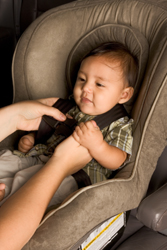Child neck simulation model
Although vast research had been previously conducted on adult vehicle occupant safety, the same was not true regarding children. In light of this, the CHILD project delved into the area of child restraint testing and regulations which has produced highly useful real world crash injury data. Additionally it has resulted in the output of real and virtual reconstructions and child based simulation methods and tools. As part of the simulation methods, child dummy models for particular body segments were developed to assist in determining injury criteria and risk curves. One example is the child neck model based on the geometry of an existing adult model but tailored according to a three-year-old child. The scaling process was necessary so that the finite element model dimensions could resemble the physical model as closely as possible. Anatomical parts that were modelled through the use of non-linear shock-absorbing springs included the head, vertebrae and major ligaments. In order to extract the soft tissues and bones in the reconstruction, the images were initially semi-automatically segmented. Following this different bones were separated one slice at a time on the previously reconstructed model. Once the anatomical structures were acknowledged, each vertebra was reassembled independently and attention was given to each process. A polymer physical model of the bones was possible with the use of a prototyping machine and can be used as a geometrical reference.



